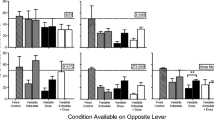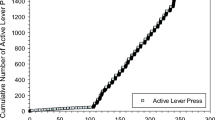Abstract
The relationship between the discriminative stimulus effects and plasma pharmacokinetics of cocaine was evaluated in six rhesus monkeys trained to discriminate cocaine (0.4 mg/kg, IM) from saline under a FR30 schedule of food presentation. The same monkeys were tested in two procedures. In a cumulative dosing procedure, five cumulative doses of cocaine (0.013–1.3 mg/kg) were administered and discriminative stimulus effects were evaluated 10 min after the administration of each dose. Cocaine plasma concentrations were measured in separate sessions using the same doses and interdose intervals. In a single dosing procedure, the time-courses of the discriminative stimulus effects and plasma concentrations of cocaine were assessed after the administration of cocaine (0.4 mg/kg). A close correspondence between cocaine's discriminative stimulus effects and plasma concentrations was obtained in both procedures. Cocaine was virtually undetectable in plasma at doses that produced saline-appropriate responding (0.013 and 0.04 mg/kg), whereas increasing plasma concentrations were measured at doses that produced primarily cocaine-appropriate responding (0.13 mg/kg or higher). The time-course of the discriminative stimulus effects of cocaine was characterized by a rapid onset (within 1–3 min post-cocaine) and offset (within 20–60 min post-cocaine). Peak plasma levels were obtained at 10 min post-cocaine. No differences in plasma concentrations were found 10 min after the administration of a cumulative versus a single dose of cocaine 0.4 mg/kg (mean, 75.8 and 74.0 ng/ml, respectively). Cocaine plasma concentrations lasted longer than its discriminative stimulus effects. The results of the present study confirm that the cumulative dosing procedure used yields plasma concentrations of cocaine that are similar to the concentrations obtained after single cocaine dosing.
Similar content being viewed by others
References
Ambre JJ, Belknap SM, Nelson J, Ruo TI, Shin SG, Atkinson AJ (1988) Acute tolerance to cocaine in humans. Clin Pharmacol Ther 44:1–8
Barnett G, Hawks R, Resnick R (1981) Cocaine pharmacokinetics in humans. J Ethnopharmacol 3:353–366
Benuck M, Lajtha A, Reith MEA (1987) Pharmacokinetics of systemically administered cocaine and locomotor stimulation in mice. J Pharmacol Exp Ther 243:144–149
Chow MJ, Ambre JJ, Ruo TI, Atkinson AJ, Bowsher DJ, Fischman MW (1985) Kinetics of cocaine distribution, elimination and chronotropic effects. Clin Pharmacol Ther 38:318–324
Colpaert FC, Niemegeers CJE, Janssen PAJ (1979) Discriminative stimulus properties of cocaine: neuropharmacological characteristics as derived from stimulus generalization experiments. Pharmacol Biochem Behav 10:535–546
Cone EJ, Kumor K, Thompson LK, Sherer M (1988) Correlation of saliva cocaine levels with plasma levels and with pharmacologic effects after intravenous cocaine administration in human subjects. J Anal Toxicol 12:200–206
Falk JL, Ma F, Lau CE (1991) Chronic oral cocaine self-administration: pharmacokinetics and effects on spontaneous and discriminative motor functions. J Pharmacol Exp Ther 257:457–465
Farré M, De la Torre R, Llorente M, Lamas X, Ugena B, Segura J, Camí J (1993) Alcohol and cocaine interactions in humans. J Pharmacol Exp Ther 266:1364–1373
Fischman MW, Schuster CR, Javaid J, Hatano Y, Davis J (1985) Acute tolerance development to the cardiovascular and subjective effects of cocaine. J Pharmacol Exp Ther 235:677–682
Foltin RW, Fischman MW (1991a) Smoked and intravenous cocaine in humans: acute tolerance, cardiovascular and subjective effects. J Pharmacol Exp Ther 257:247–261
Foltin RW, Fischman MW (1991b) Assessment of abuse liability of stimulant drugs in humans: a methodological survey. Drug Alcohol Depend 28:3–48
Galeazzi RL (1985) Pharmacodynamics, pharmacokinetics, or both? In: Barnett G, Chiang CN (eds) Pharmacokinetics and pharmacodynamics of psychoactive drugs. Biomedical Publications, Foster City, Calif., pp 169–184
Gibaldi M, Perrier D (1982) Pharmacokinetics, 2nd edn. Marcel Dekker, New York
Gintautas J, Angus L, Levendoglu H, Abadir AR (1993) Serum cocaine in the rat: behavior and pharmacokinetic study. Proc West Pharmacol Soc 36:165–166
Inaba T (1989) Cocaine: pharmacokinetics and biotransformation in man. Can J Physiol Pharmacol 67:1154–1157
Jacob P, Elias-Baker BA, Jones RT, Benowitz NL (1987) Determination of benzoylecgonine and cocaine in biologic fluids by automated gas chromatography. J Chromatogr 417:277–286
Javaid JI, Fischman MW, Schuster CR, Dekirmenjian H, Davis JM (1978) Cocaine plasma concentration: relation to physiological effects in humans. Science 202:227–228
Javaid JI, Musa MN, Fischman M, Schuster CR, Davis JM (1983) Kinetics of cocaine in humans after intravenous and intranasal administration. Biopharm Drug Dispos 4:9–18
Jeffcoat AR, Perez-Reyes M, Hill JM, Sadler BM, Cook CE (1989) Cocaine disposition in humans after intravenous injection, nasal insufflation (snorting), or smoking. Drug Metab Dispos 17:153–159
Johanson CE, Barrett JE (1993) The discriminative stimulus effects of cocaine in pigeons. J Pharmacol Exp Ther 267:1–8
Johanson CE, Fischman MW (1989) The pharmacology of cocaine related to its abuse. Pharmacol Rev 41:3–52
Kleven MS, Anthony EW, Woolverton WL (1990) Pharmacological characterization of the discriminative stimulus effects of cocaine in rhesus monkeys. J Pharmacol Exp Ther 254:312–317
Lau CE, Imam A, Falk JL (1991) Acute effects of cocaine on spontaneous and discriminative motor functions: relation to route of administration and pharmacokinetics. J Pharmacol Exp Ther 257:444–456
Lukas SE, Scholar M, Kouri M, Fukuzako H, Mendelson JH (1994) Marihuana smoking increases plasma cocaine levels and subjective reports of euphoria in male volunteers. Pharmacol Biochem Behav 48:715–721
Misra AL, Giri VV, Patel MN, Alluri VR, Mulé J (1977) Disposition and metabolism of [3H] cocaine in acutely and chronically treated monkeys. Drug Alcohol Depend 2:261–272
Negus SS, Mello NK, Portoghese PS, Lukas SE, Mendelson JH (1995) Role of delta opioid receptors in the reinforcing and discriminative stimulus effects of cocaine in rhesus monkeys. J Pharmacol Exp Ther 273:1245–1256
Nielsen EB (1993) Regulation of drug discrimination behaviour by dopamine D1 and D2 receptors. In: Waddington JL (ed) D1: D2 dopamine receptor interactions. Academic Press, London, pp 159–173
Oliveto AH, Rosen MI, Woods SW, Kosten TR (1995) Discriminative stimulus, self-reported and cardiovascular effects of orally administered cocaine in humans. J Pharmacol Exp Ther 272:231–241
Perez-Reyes M, Jeffcoat AR, Myers M, Sihler K, Cook CE (1994) Comparison in humans of the potency and pharmacokinetics of intravenously injected cocaethylene and cocaine. Psychopharmacology 116:428–432
Schuster CR, Johanson CE (1988) Relationship between the discriminative stimulus properties and subjective effects of drugs. In: Colpaert FC, Balster RL (eds) Psychopharmacology, series 4: transduction mechanisms of drug stimuli. Springer, Berlin, pp 161–175
Spealman RD, Bergman J, Madras BK, Melia KF (1991) Discriminative stimulus effects of cocaine in squirrel monkeys: involvement of dopamine receptor subtypes. J Pharmacol Exp Ther 258:945–953
Teoh SK, Mendelson JH, Mello NK, Kuehnle J, Sintavanarong P, Rhoades EM (1993) Acute interactions of buprenorphine with intravenous cocaine and morphine: an investigational new drug phase I safety evaluation. J Clin Psychopharmacol 13:87–99
Teoh SK, Mello NK, Mendelson JH, Kuehnle J, Gastfriend DR, Rhoades EM, Sholar W (1994) Buprenorphine effects on morphine-and cocaine-induced subjective responses by drug-dependent men. J Clin Psychopharmacol 14:15–27
Wood DM, Emmett-Oglesby MW (1989) Mediation in the nucleus accumbens of the discriminative stimulus produced by cocaine. Pharmacol Biochem Behav 33:453–457
Author information
Authors and Affiliations
Additional information
In Memoriam: Xavier Lamas, MD, phD; August 26, 1995; Mt. Everest
This work was supported by in part by grants DA 02159, DA 04059, DA 07252 and KO award DA 00101 from the National Institute on Drug Abuse, NIH. Xavier Lamas was supported by a grant from the Ministry of Education and Science of Spain (“Formación del Personal Investigador, Subprograma de Perfeccionamiento para Doctores y Tecnólogos”). Animals used in this study were maintained in accordance with guidelines of the Committee on Care and Use of Laboratory Animal Resources, National Research Council (Department of Health, Education and Welfare, Publication No. (NIH) 85–23, revised 1985), and the McLean Hospital Institutional Animal Care and Use Committee.
Rights and permissions
About this article
Cite this article
Lamas, X., Negus, S.S., Hall, E. et al. Relationship between the discriminative stimulus effects and plasma concentrations of intramuscular cocaine in rhesus monkeys. Psychopharmacology 121, 331–338 (1995). https://doi.org/10.1007/BF02246072
Received:
Revised:
Issue Date:
DOI: https://doi.org/10.1007/BF02246072




